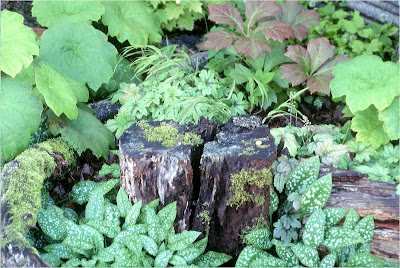However for the biodiversity in your garden dead trees or very old and half passed away trees are even more important. There are for instance only about 30 different species of beetles depending on still living Scotch Pine (Pinus sylvestris) for their survival, but more than 300 species need dead pines to complete their life cycles, and more than 500 different species of beetles are living on dead oak trees (Quercus robur). Dead trees are thus actually more important in your garden, at least for insects and other invertebrates.
How can we then involve more of dead wood in the garden design in a natural and pleasant way? Well, here are some pictures from a patio I made in Gothenburg for an exhibition some years ago. A lot of dead branches and stumps are placed among the plants and in my opinion the planting looks even more naturally untidy and very beautiful with all the mosses growing on the dead wood. The planting was made just some few weeks before I took the photos, but still it already looked rather settled.
The wood is dead! Long live the dead wood in your garden! Don't you agree? The insects certainly do.




Yes i agree! Long live the dead wood:) You did a fantastic job in Amhult, this one is one of the best i.m.o. Very beautiful and inspirational.
ReplyDelete/Magnus
So true, so true. This is really my favourite area; try to introduce biodiversity into the garden! The way you treat dead tree here is sophisticated and looks great. Another way to keep dead tree in gardens is to establish woodpiles, isn’t it? Woodpiles can be very decorative.
ReplyDelete//Kristina
Our dead wood, is chopped up grape vines that have been discarded. Used by our neighbours for braaiing/BBQ. Ours is banked up as a wildlife habitat giving lizards and mice and frogs and snakes somewhere to escape.
ReplyDeleteWoodpiles are also high grade beneficial for biodiversity. If you make small, deep holes with different sizes in the trunks, solitary bees and other insect can lay their eggs inside them.
ReplyDeleteI agree with you that these piles can be very beautiful, especially if they are made up by old trailing branches of dead grape vines as at Elephant's Eye's place. Sounds wonderful, although I do appreciate grilled food and also a bottle of red wine from still living grapes...